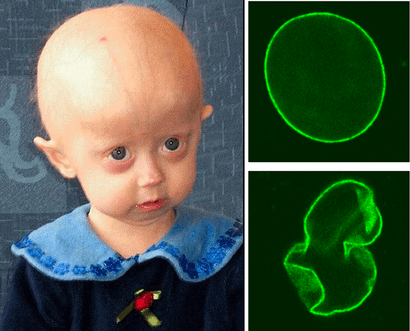Progeria facts for kids
Quick facts for kids Progeria |
|
|---|---|
| Synonyms | Hutchinson–Gilford progeria syndrome (HGPS), progeria syndrome |
 |
|
| A young girl with progeria (left). A healthy cell nucleus (right, top) and a progeric cell nucleus (right, bottom). | |
| Symptoms | Growth delay, short height, small face, hair loss |
| Complications | Heart disease, stroke, hip dislocations |
| Usual onset | 9–24 months |
| Causes | Genetic |
| Diagnostic method | Based on symptoms, genetic tests |
| Similar conditions | Hallermann–Streiff syndrome, Gottron's syndrome, Wiedemann–Rautenstrauch syndrome |
| Treatment | Mostly symptomatic |
| Medication | Lonafarnib |
| Prognosis | Average age of death is 13 years |
| Frequency | Rare: 1 in 18 million |
Progeria is a very rare genetic disorder. It makes a person's body show signs of aging much faster than normal. People with progeria are born looking like typical babies. But by their first or second birthday, they start to look like they are getting old very quickly. This condition is also known as Hutchinson–Gilford progeria syndrome (HGPS).
The word progeria comes from two Greek words. "Pro" means "before" or "premature". "Gēras" means "old age". So, progeria means "premature old age."
Contents
What is Progeria?
Progeria is a type of genetic disorder. This means it is caused by a change in a person's DNA. It is an "autosomal dominant" condition. This means only one copy of a changed gene is needed for the condition to appear.
People with progeria usually live to their mid-teens or early twenties. Scientists are very interested in progeria. Studying it might help us understand more about the normal process of aging.
How Does Progeria Happen?
Progeria happens because of a new mutation (a change) in a specific gene. This change usually happens by chance. It is very rarely passed down from parents to children. This is because people with progeria often do not live long enough to have children.
The problem lies in a gene called LMNA. This gene gives instructions for making a protein called lamin A. Lamin A is like a building block that helps hold the cell nucleus together. The nucleus is the control center of every cell in our body.
When the LMNA gene has a mistake, it produces an abnormal form of lamin A called progerin. This faulty progerin protein makes the cell nucleus weak and unstable. This instability makes it hard for cells to divide properly and function well. It's like trying to build a house with faulty materials – the house won't be strong. This cellular problem is what leads to the rapid aging seen in progeria.
Signs and Symptoms
Children with progeria start showing signs of aging early. These signs usually appear between 9 and 24 months old.
- They grow slowly and are shorter than other kids their age.
- They often have a small face and a small jaw.
- They lose their hair, including their eyelashes and eyebrows.
- Their skin can become thin and wrinkled.
- They might have problems with their joints, like hip dislocations.
The most serious problems are often related to the heart. Children with progeria can develop heart disease or have a stroke. These are the main causes of death for people with the condition.
History of Discovery
Progeria was first described in 1886 by a doctor named Jonathan Hutchinson. Another doctor, Hastings Gilford, described it independently in 1897. Because of their work, the condition was later named Hutchinson–Gilford progeria syndrome.
How Common is Progeria?
Progeria is an extremely rare condition. Studies suggest it affects about 1 in every 20 million births. As of September 2020, the Progeria Research Foundation knew of 179 cases worldwide, spread across 53 countries. They believe there might be around 150 more cases that haven't been diagnosed yet.
Treatments for Progeria
In November 2020, the U.S. Food and Drug Administration approved a medicine called lonafarnib. This drug helps prevent the buildup of the faulty progerin protein inside cells. Studies have shown that lonafarnib can significantly improve the survival rate for children with progeria. It is taken twice a day in capsule form.
Other treatments focus on managing the problems caused by progeria. For example, doctors might treat heart problems with medicines or even surgery. Low-dose aspirin can also be used. Scientists are also researching other potential treatments, including different types of drugs and gene-editing techniques, to find even better ways to help children with progeria.
Living with Progeria
Sadly, there is no known cure for progeria, and the average life expectancy for children with the condition is around 13 years. Most patients pass away from complications related to heart disease or stroke.
It's important to know that progeria does not affect a child's mental development. Children with progeria usually have average or even above-average intelligence. While their bodies age very quickly, about eight to ten times faster than normal, they don't develop all the problems associated with typical aging. For example, they usually don't get cataracts (cloudy eyes) or osteoarthritis (joint wear and tear).
While there isn't a cure for progeria itself, treatments for its complications have helped some patients live longer. For instance, one patient lived until age 28. People with progeria can also have normal reproductive development.
Images for kids
See also
 In Spanish: Progeria para niños
In Spanish: Progeria para niños

